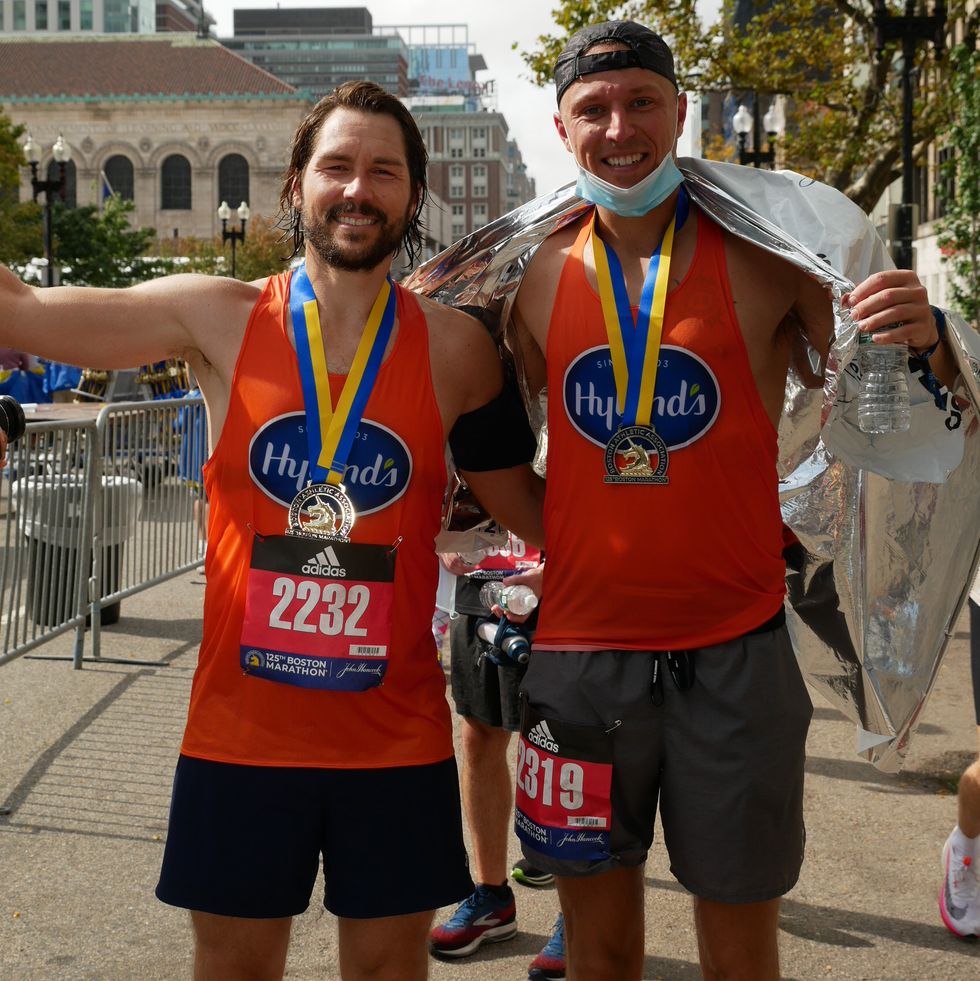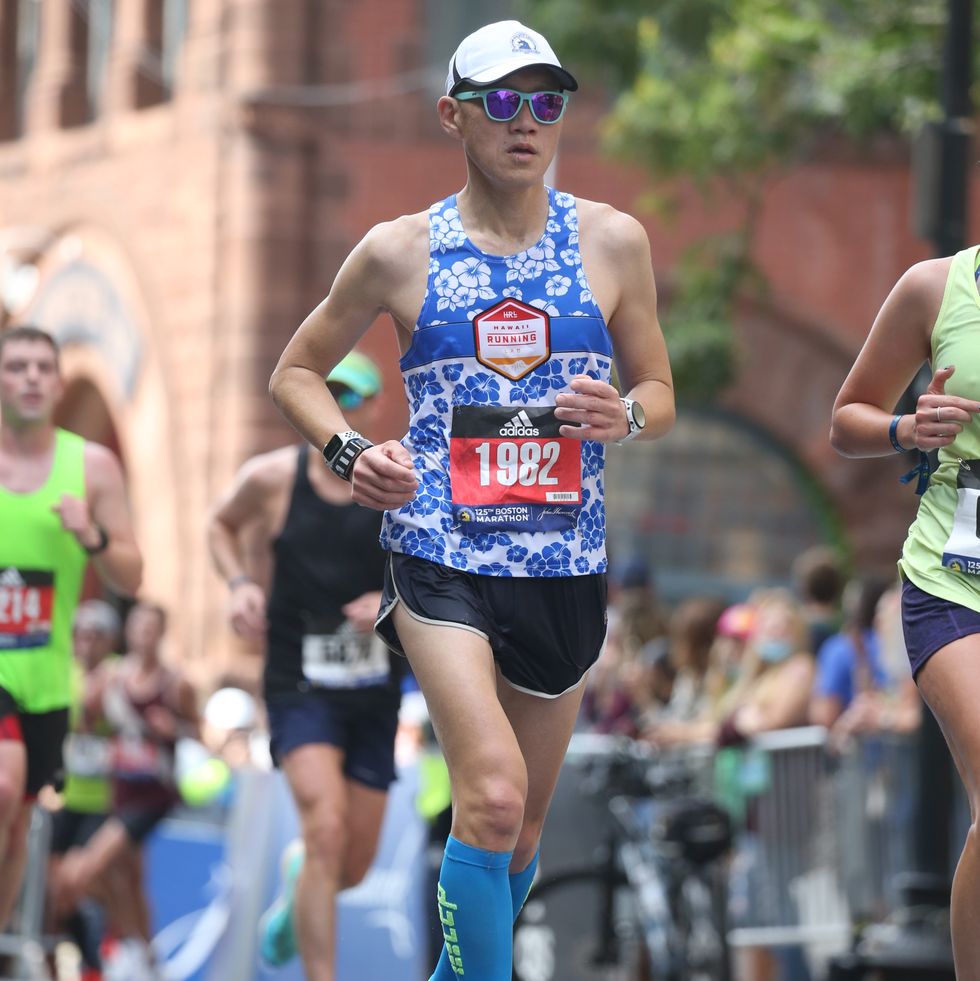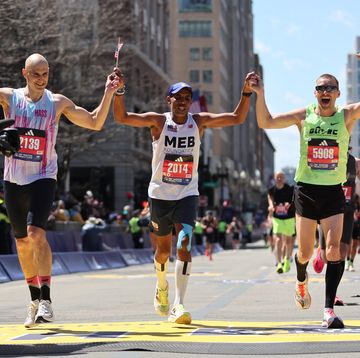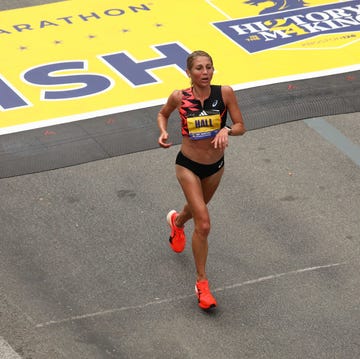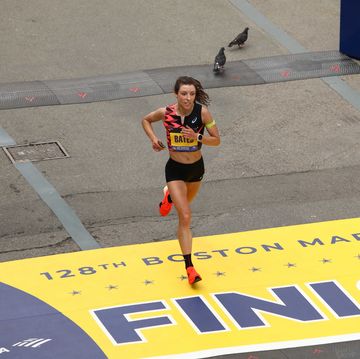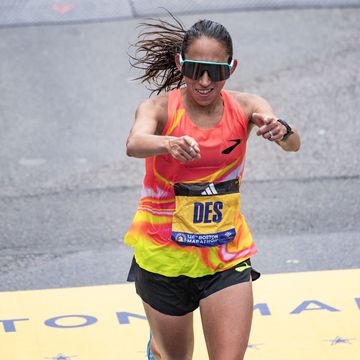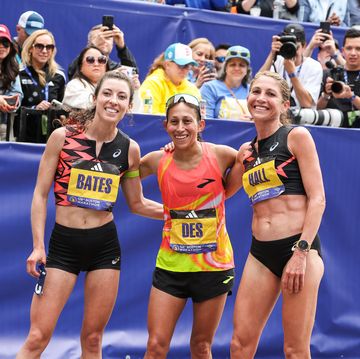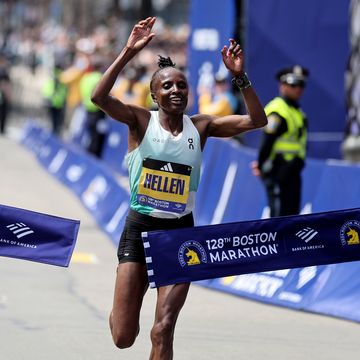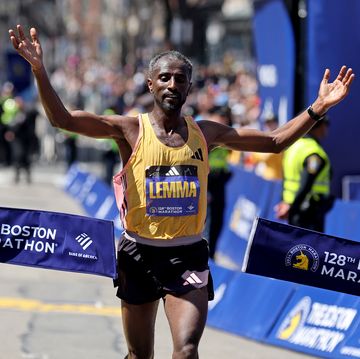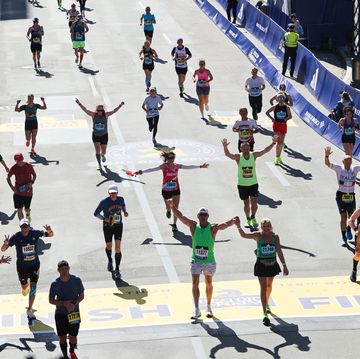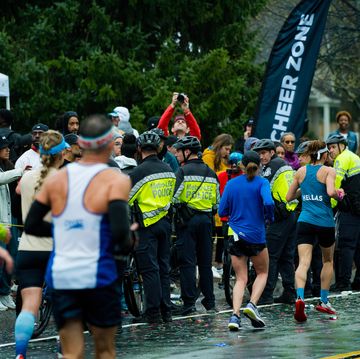A week after the Boston Marathon, Meghan Roth is home in Edina, Minnesota, caring for her nine-month-old son. She’s still sore from surgery to implant an ICD—a battery-operated defibrillator—near her heart.
But she’s recovering from what she never saw coming: suffering cardiac arrest at the 7.4-mile mark of the race.
Roth, 34, said in an interview with Runner’s World that she remembered things getting fuzzy for a few seconds before she collapsed on the course, but that’s all she knew until she woke up in an ambulance. “In seconds my life literally went crashing down,” she wrote on Facebook.
The fact Roth made it home alive so quickly after the race is miraculous, experts say. For that, she has three other runners to thank, as well as bystanders she may never know.
Roth is a running coach and herself a sub-elite runner. She ran her PR, 2:44:03, at the 2019 Boston Marathon (pictured above), and that performance qualified her for the 2020 Olympic Marathon Trials in Atlanta. She said she was in shape to PR again on October 11 in Boston, thinking 2:42 was possible. In her early miles, she was “cruising along.”
She collapsed in Framingham, almost at the Natick border.
Immediately marathon spectators came to her aid. A woman performed CPR, and a young man held her airway open. Another woman stood in front of where Roth was on the ground, directing runners around her, and someone called 911. Runner’s World has so far been unsuccessful in identifying those spectators.
Nick Haney, a firefighter and a paramedic who lives in Milwaukie, Oregon, a Portland suburb, was the first runner to stop for Roth. He had been aiming for a marathon in the 2:52 range when he saw the commotion around her. When he drew even with Roth, he thought to himself, “Oh, shoot, they’re actually doing CPR. Okay, I have to stop.”
Haney is accustomed to being the first one on the scene after a 911 call. He and his fellow firefighters show up and do the same things paramedics on ambulances do, he said.
Roth was blue in the face at that point from lack of oxygen in the blood. He took a closer look and realized he had met Roth before. The community of sub-elite runners is small that way. Instinctively, he clicked off his watch and took over chest compressions.
David Pai was the next runner to join the effort. He’s a physician in Sacramento, California, who specializes in kidneys. He had run the London Marathon a week earlier and was still feeling sore, with no great expectations for Boston. Pai was a few feet past Roth, when he looked over and saw her lying on the ground. He decided to stop, so he also turned off his watch and headed back to help.
He administered a precordial thump—essentially striking her chest in an attempt to get the heart back to its normal rhythm. Then, as Haney continued administering CPR, Pai lifted her legs so blood would flow toward her core.
Tanner Smith happened upon the group next. Smith and Haney know each other—both run for a team sponsored by Hyland’s, a company that makes muscle ointment—and they had ridden the bus together to Hopkinton. Smith knew Haney had been aiming for a PR.
“I had him in my sight off in the distance for the majority of those first eight miles,” Smith said of Haney in his orange Hyland’s singlet. “That he was stopped, either he’s injured or something serious is going on.”
Smith had the same instinct: Stop and help (after he, too, pressed the button to stop his watch). Smith is an ER physician assistant at Sunrise Hospital in Las Vegas. He had been on duty on the night in 2017 when a gunman opened fire at a concert, killing 59 people and wounding 500 others. Sunrise received 200 victims in a span of two hours that night.
“I’ve seen a lot in the years that I’ve been practicing in the ER,” Smith said. “You kind of adapt and figure things out. Not that it’s ever easy.”
Smith and Haney alternated rounds of CPR, and Smith noticed that Roth’s color was improving as they were working on her. A short time later, a small team from the Natick Fire Department, riding a Polaris ATV, arrived on the scene. An ambulance was not far behind. They shocked Roth’s heart with an AED and transported her to MetroWest Hospital in Framingham.
Haney, Smith, and Pai spoke briefly. Then they did what runners do: They restarted their watches and resumed running the 18 miles to the marathon finish line. Haney was stopped for almost exactly five minutes, and the other two were stopped for less.
“I can’t tell you how many times I’ve done CPR on people,” Haney said. “It was like work mode. There was a shock factor to it, but I’ve done those types of things like that at work. You have to be able to see things, do things, and kind of let them roll off your back.”
He finished in 3:02:17; Roth later joked with him that if he hadn’t stopped to save her life, he would have broken three hours.
Smith, too, welcomed the long road to the finish. “The 18 miles was good for me,” he said. “Running is an outlet from a lot of stress. It was nice to have the remainder of the marathon to reflect on what just happened. It was miraculous that we happened to be there and not too much time had passed.” He finished in 3:12:18.
Pai finished in 3:28:13, thinking of Roth the rest of the way. “Gosh, you hope she’s okay,” he said. “You just put one foot in front of the other and get done with it and find out how she is, that’s the biggest thing.”
What are the odds? A marathoner has a heart attack on the course, and a paramedic, an ER physician assistant, and a physician are running right behind her? Roth knows she couldn’t have been luckier.
“I’m so grateful,” she said. “They are heroes.”
Pai highlights the quick action of the spectators. “We were there to help, but whoever that person was who reacted first before any of the runners, she really saved that woman’s life,” he said. “We just helped out to support what that woman was doing. It was great. She was the one.”
Chris DiBona, who works for Brewster, the ambulance company that transported Roth, also had praise for the bystanders and runners.
“That CPR and early defibrillation were literally keys to her survival,” he said. “In a world where people are first to pick up their camera phones and record, rather than act—it speaks to strength of the running community.”

Sarah Lorge Butler is a writer and editor living in Eugene, Oregon, and her stories about the sport, its trends, and fascinating individuals have appeared in Runner’s World since 2005. She is the author of two popular fitness books, Run Your Butt Off! and Walk Your Butt Off!

